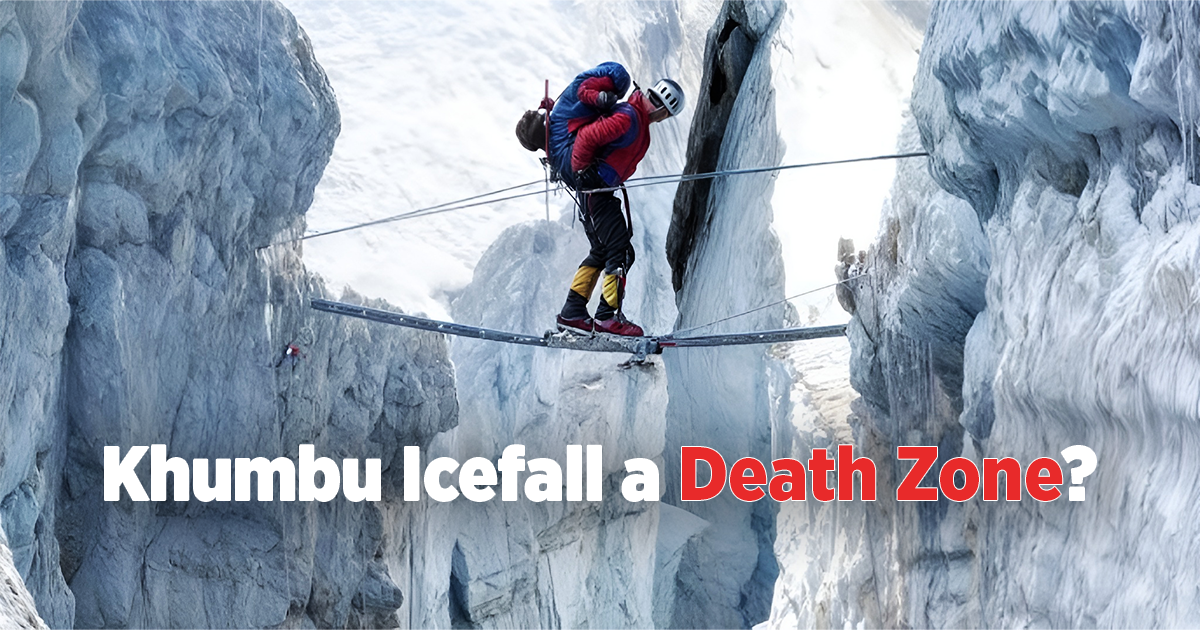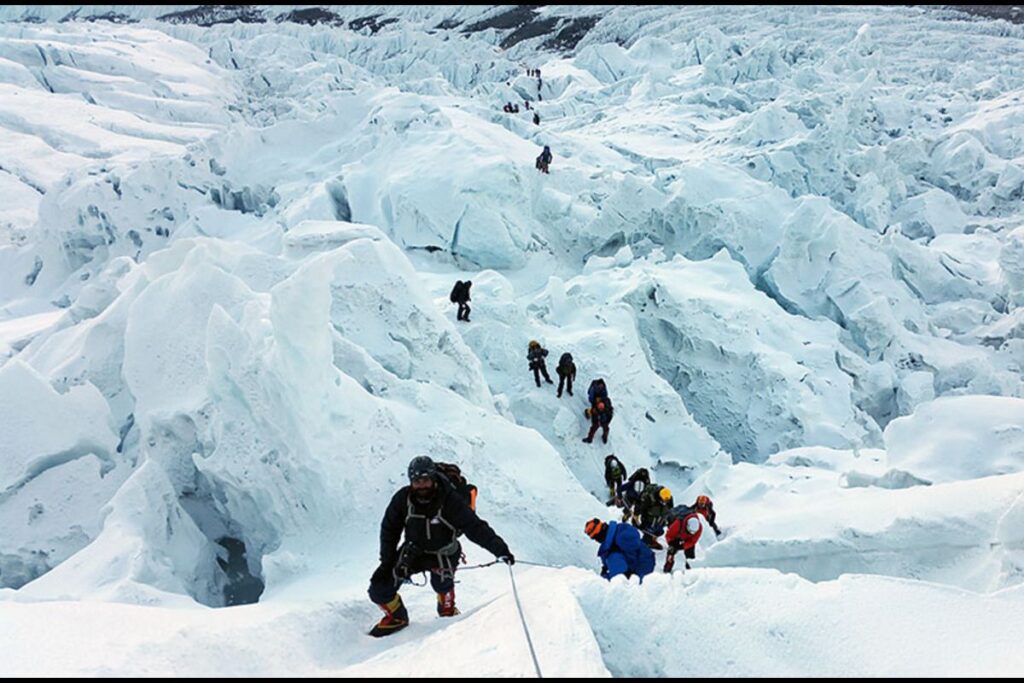Is Khumbu Icefall a Death Zone in Everest?

From the bustling trails to the calm of base camp, the adventure of summiting Mount Everest slowly turns into a serious test of strength and survival.
Among them lies a section so feared and unpredictable that it has claimed lives even before the real climb begins: the Khumbu Icefall.
The Khumbu Icefall was known for its deadly unpredictability, long before Hillary and Tenzing made history on Everest. Over the years, many mountain enthusiasts have always had a common question on their mind—does it fall into one of the mountain’s death zones?
In this blog, we uncover the truth behind this infamous section and how Mount Elegance Treks and Expedition help climbers face it safely.
Table of Contents
- Khumbu Icefall: Is It One of Everest’s Death Zones?
- The Role of Sherpas in Crossing the Icefall
- Is It Possible to Avoid the Khumbu Icefall Route?
- The Changing Face of the Khumbu Icefall: Impact of Climate Change
- What Happens if Someone Falls Into the Khumbu Icefall?
- How far is the Khumbu Icefall from the Everest Base Camp?
- What Makes a “Death Zone” on Everest?
- Trek to Everest Base Camp Safely With Mount Elegance Treks and Expeditions
Khumbu Icefall: Is It One of Everest’s Death Zones?
When we think of Mount Everest, our minds often go straight to the infamous “death zone”—the dangerous altitude where survival becomes a race against time. Likewise, the Khumbu Icefall is one of the most dangerous parts of the Everest climb. However, it is not technically in the “death zone.”
The term “death zone” refers to altitudes above 8,000 meters (26,247 feet) where oxygen levels are so low that the human body cannot adapt. Staying too long at this height leads to a rapid breakdown of bodily functions, and even simple tasks can become life-threatening.
The Khumbu Icefall, however, lies much lower—between 5,500 and 5,800 meters (18,000 to 19,000 feet)—just above Everest Base Camp. Despite being outside the death zone, it is infamous for its unstable ice towers (seracs), deep crevasses, and sudden avalanches.
What makes it especially deadly is its constant movement; the ice shifts and cracks throughout the day, making every crossing a gamble. Climbers usually attempt to pass through it early in the morning, when colder temperatures slightly reduce the risk of collapse.
So while the Khumbu Icefall isn’t part of Everest’s official death zone by altitude, it certainly earns its reputation as a death zone by danger. Many lives have been lost here, and it remains one of the most feared sections of the climb.
The Role of Sherpas in Crossing the Icefall
Sherpas play a crucial and heroic role in helping climbers navigate the treacherous Khumbu Icefall—one of the most dangerous sections of the Everest route.
The Icefall is a constantly shifting maze of towering seracs, deep crevasses, and unstable ice blocks that can collapse without warning. A specialized group of Sherpas, known as the Icefall Doctors, is responsible for fixing ropes, ladders, and anchors across this unsafe route.
They make the first crossings each season, often in the dark, cold hours of early morning when the ice is more stable. These brave individuals risk their lives to build and maintain a route so that others can pass safely.
Beyond physical strength, their deep familiarity with the region, weather patterns, and route makes them invaluable. Their contributions are not just supportive—they are foundational to the success and safety of any Everest expedition.
Is It Possible to Avoid the Khumbu Icefall Route?
Yes, it is possible—but only by choosing a different route entirely. The Khumbu Icefall is part of the South Col route from Nepal, which is the most popular and traditional path to the summit.
To avoid it, climbers must take the North Ridge route from Tibet (China). This route approaches Everest from the north side and completely bypasses the Khumbu Icefall.
However, the North route comes with its own challenges—higher winds, colder temperatures, and a technically demanding final push to the summit. Moreover, access to the north side depends on permits from Chinese authorities, which are sometimes restricted.
In short, avoiding the Khumbu Icefall is possible, but it means choosing a tougher, more politically complex, and less frequently used path to the top of the world.
The Changing Face of the Khumbu Icefall: Impact of Climate Change
The Khumbu Icefall has long been known as one of the most treacherous and awe-inspiring parts of the Everest climb. This shifting maze of towering ice blocks and deep crevasses is constantly moving, making it one of the deadliest sections on the mountain.
Rising global temperatures are melting the glaciers that feed the Icefall. This makes the ice more unstable and increases the risk of avalanches and collapses.
These changes are not only raising the danger for climbers and Sherpa Icefall Doctors, but also shortening the already brief climbing season. Unpredictable ice conditions mean that the window for safe crossing grows smaller each year, forcing expeditions to adapt or face greater risks.
Furthermore, local communities that rely heavily on Everest tourism for their livelihood are feeling the impact. Fewer climbers mean reduced income, and the increased dangers discourage some from attempting the ascent altogether.
As climate change reshapes the Khumbu Icefall, it serves as a powerful reminder that even the highest, most remote places on Earth are vulnerable. For those dreaming of Everest, understanding these challenges is key to appreciating the mountain’s raw power and the urgent need to protect our planet.
What Happens if Someone Falls Into the Khumbu Icefall?
Falling into the Khumbu Icefall is one of the most dangerous and terrifying accidents on Everest. The Icefall is full of deep, hidden crevasses—some hundreds of feet deep—covered by fragile snow bridges that can collapse without warning. If a climber falls in, immediate rescue is extremely difficult due to the unstable ice, remote location, and harsh weather.
Rescuers may attempt a risky recovery using ropes and ladders, but their success depends on how quickly they notice the fall and how accessible the location is. Unfortunately, shifting ice often traps, injures, or buries victims in the Icefall, making many falls fatal.
This is why climbers take extreme precautions—using fixed ropes, traveling with experienced guides, and crossing during early morning hours when the ice is more stable. Despite all precautions, the Khumbu Icefall remains one of the most perilous parts of the Everest climb.
How far is the Khumbu Icefall from the Everest Base Camp?
The Khumbu Icefall begins just above the Everest South Base Camp on the Nepal side and stretches about 1 to 2 kilometers (0.6 to 1.2 miles) uphill toward Camp I.
Although the distance is short, the Icefall is a dangerous and constantly moving river of ice, filled with deep crevasses and towering ice blocks.

Climbers and their Sherpas in the Khumbu Icefall region.
(Image Credit: Satori Adventures)
Crossing it requires climbers to navigate ladders and fixed ropes carefully, and it can take several hours to complete. Most climbers cross early in the morning when the ice is colder and more stable, making it one of the most challenging sections of the Everest climb.
What Makes a “Death Zone” on Everest?
The “Death Zone” on Everest refers to altitudes above 8,000 meters (26,247 feet), where the oxygen level is so low that the human body can no longer acclimate.
At this height, cells begin to die, decision-making slows down, and even simple tasks become exhausting. Staying too long can lead to life-threatening conditions like high-altitude cerebral edema (HACE) or pulmonary edema (HAPE).
Most climbers use supplemental oxygen, but even that isn’t a guarantee of safety. The weather is extreme, rescue is nearly impossible, and time is limited—hence the name “Death Zone.” It’s the most dangerous part of the climb, where every step toward the summit can be a fight for survival.
Trek to Everest Base Camp Safely With Mount Elegance Treks and Expeditions
The Everest Base Camp trek is a once-in-a-lifetime adventure—and at Mount Elegance Treks and Expeditions (@mount_elegance_treks), we make sure it’s not only unforgettable but also safe and smooth from start to finish.
Whether you’re a seasoned hiker or a first-time trekker, our experienced guides and well-crafted itinerary are designed to help you acclimatize properly, avoid altitude sickness, and enjoy every step through the heart of the Himalayas.
From Lukla to Namche, Tengboche to Base Camp itself, you’ll be walking among the giants, with expert support every step of the way. We handle all logistics, including permits, lodging, meals, and daily briefings—so you can focus on soaking in the views, not stressing about the journey.
Join us for a safe, scenic, and soul-stirring trek to the foot of Mount Everest.
